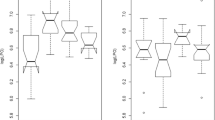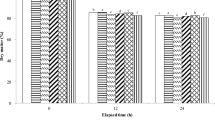Abstract
We examined the docosahexaenoic acid (DHA) requirement during the sensitive period (D–E stages) to prevent abnormal morphology in juvenile brown sole Pseudopleuronectes herzensteini. Rotifers and Artemia nauplii containing three graded levels (low, mid, and high level) of DHA were made by respective enrichment with oil emulsion. Larvae at 15 days post hatching (dph) (D stage) were fed for 10 days with rotifers and Artemia nauplii containing respective amounts of DHA. During F–I stages, larvae were fed Artemia nauplii enriched with a commercial supplementary diet. The DHA requirement to prevent morphological abnormalities in brown sole juveniles was estimated to be 1.7–3.2% in rotifer and 1.4–2.8% in Artemia nauplii on a dry weight basis. Moreover it was clearly demonstrated that DHA enrichment of rotifers is superior to that of Artemia nauplii for this purpose in larval brown sole during D–E stages.


Similar content being viewed by others
References
Saotome K, Aritaki M (1988) Magarei jinkoushubyou no taisyokuijyou to keitaiijyou. (Abnormalities of body colour and eye position in hatchery-reared brown sole (Pseudopleuronectes herzensteini) juveniles). Saibai Giken 17:9–17 (in Japanese)
Seikai T (2005) Expression of anomalous pigmentation in flatfishes caused by wavered asymmetry. Nippon Suisan Gakkaishi 71:996–997 (in Japanese)
Aritaki M (2008) Studies on the morphological abnormalities related to metamorphosis and its prevention for flatfishes. Nippon Suisan Gakkaishi 74:772–775 (in Japanese)
Tagawa M, Aritaki M (2005) Production of symmetrical flatfish by controlling the timing of thyroid hormone treatment in spotted halibut Verasper variegatus. Gen Comp Endocrinol 141:184–189
Takeuchi T (1997) Essential fatty acid requirements of aquatic animals with emphasis on fish larvae and fingerlings. Rev Fish Sci 5:1–25
Takeuchi T (2001) A review of feed development for early life stages of marine finfish in Japan. Aquaculture 200:203–222
Satoh N, Takeuchi T (2009) Docosahexaenoic acid requirement of larval brown sole Pseudopleuronectes herzensteini. Nippon Suisan Gakkaishi 75:28–37 (in Japanese with English abstract)
Satoh N, Takeuchi T (2009) Estimation of sensitive period for the abnormal morphology in hatchery-reared brown sole Pseudopleuronectes herzensteini fed live food enriched with docosahexaenoic acid. Fish Sci (in press)
Satoh N, Fujioka T, Shimizu Y (2003) Ingestion of live food by the larvae of Brown sole Pseudopleuronectes herzensteini at different temperatures in the Hokkaido region. Sci Rep Hokkaido Fish Exp Stn 64:113–120 (in Japanese with English abstract)
Satoh N, Fujioka T, Shimizu Y, Takeuchi T (2006) Effect of live food enrichment on survival, growth, pigmentation and starvation resistance in larval brown sole (Pleuronectes herzensteini). Aquac Sci 54:305–312 (in Japanese with English abstract)
Aritaki M, Seikai T (2004) Temperature effects on early development and occurrence of metamorphosis-related morphological abnormalities in hatchery-reared brown sole Pseudopleuronectes herzensteini. Aquaculture 240:517–530
Yamada S, Kitada S (2003) Seibutsushigen toukeigaku. (Statistics of Fisheries Resources). Seizando, Tokyo, pp 93–121 (in Japanese)
Venizeros A, Benetti DD (1999) Pigment abnormalities in flatfish. Aquaculture 176:181–188
Bolker JA, Hill CR (2000) Pigmentation development in hatchery-reared flatfishes. J Fish Biol 56:1029–1052
Takeuchi T (1997) Kenbyouikusei to eiyouyoukyu. (Health management of hatchery stock and nutritional requirements in flatfish). In: Minami T, Tanaka M (eds) Hirame no seibutsugaku to shigenbaiyou. (Biology and stock enhancement of Japanese flounder). Koseisha Koseikaku, Tokyo, pp 96–106
Reitan KI, Rainuzzo JR, Olsen Y (1994) Influence of lipid composition of live feed on growth, survival and pigmentation of turbot larvae. Aquacult Int 2:33–48
Shields RJ, Bell JG, Luizi FS, Gara B, Bromage NR, Sargent JR (1999) Natural copepods are superior to enriched Artemia nauplii as feed for halibut larvae (Hippoglossus hipoglossus) in terms of survival, pigmentation and retinal morphology: Relation to dietary essential fatty acids. J Nutr 129:1186–1194
Kanazawa A (1993) Nutritional mechanisms involved in the occurrence of abnormal pigmentation in hatchery-reared flatfish. J World Aquac Soc 24:162–166
Satoh N, Takaya Y, Takeuchi T (2009) The effect of docosahexaenoic and eicosapentaenoic acids in live food on the development of abnormal morphology in hatchery-reared brown sole Pseudopleuronectes herzensteini. Fish Sci (in press)
Estevez A, Kanazawa A (1996) Fatty acid composition of neural tissues of normally pigmented and unpigmented juveniles of Japanese flounder using rotifer and Artemia enriched with n-3 HUFA. Fish Sci 62:88–93
Song X, Zhang X, Guo N, Zhu L, Kuang C (2007) Assessment of marine thraustochytrid Schizochytrium limacinum OUC88 for mariculture by enriched feeds. Fish Sci 73:565–573
Furuita H, Takeuchi T, Uematsu K (1998) Effects of eicosapentaenoic and docosahexaenoic acids on growth, survival and brain development of larval Japanese flounder Paralichthys olivaceus. Aquaculture 161:269–279
Suzuki T, Aritaki M, Uzi T, Hashimoto H (2007) Approach to the mysteries of asymmetrical formation in flatfish species. Kagaku to Seibutsu 45:511–515
Naas T, Lie O (1998) A sensitive period during first feeding for the determination of pigmentation pattern in Atlantic halibut, Hippoglossus hippoglossus L., juveniles: the role of diet. Aquacult Res 29:925–934
Solbakken JS, Pittman K (2004) Photoperiodic modulation of metamorphosis in Atlantic halibut (Hippoglossus hippoglossus L.). Aquaculture 232:613–625
Acknowledgments
The authors extend their thanks to Shoji Yoshida of the Tomakomai Fisheries Association in Hokkaido, Japan, for capturing the brown sole broodstock. Mitsuru Sannohe and Kosuke Haga from Erimo Town in Hokkaido, Japan, are thanked their assistance with rearing techniques. In addition, Drs. Yutaka Haga and Lu Jun, Tokyo University of Marine Science and Technology, are thanked for valuable advice with this manuscript.
Author information
Authors and Affiliations
Corresponding author
Rights and permissions
About this article
Cite this article
Satoh, N., Takaya, Y. & Takeuchi, T. Docosahexaenoic acid requirement for the prevention of abnormal morphology in brown sole Pseudopleuronectes herzensteini during D–E larval stages. Fish Sci 75, 1259–1266 (2009). https://doi.org/10.1007/s12562-009-0134-9
Received:
Accepted:
Published:
Issue Date:
DOI: https://doi.org/10.1007/s12562-009-0134-9




